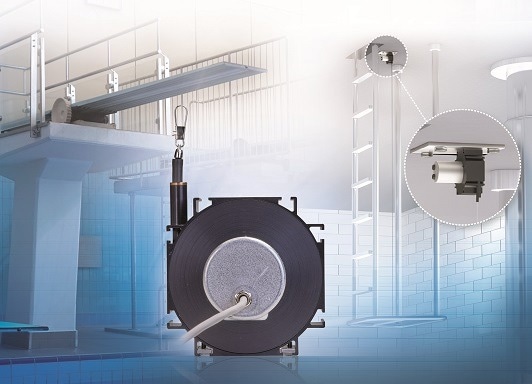Synchronised diving is the art of performing the most difficult dive at precisely the same time as your partner. Here, not only does the talent of the divers and their continuous, intense training count, but also a perfect technique. There is also technology in the diving platforms, which must be positioned to exactly the same height in order to ensure a uniform, fair diving situation. The Leipzig water sports centre relies on precise, robust draw-wire displacement sensors from Micro-Epsilon for measuring the lifting height.
 The Leipzig water sports centre relies on precise and robust draw-wire displacement sensors from Micro-Epsilon for measuring the lifting height of diving board platforms. Image Credit: Micro-Epsilon
The Leipzig water sports centre relies on precise and robust draw-wire displacement sensors from Micro-Epsilon for measuring the lifting height of diving board platforms. Image Credit: Micro-Epsilon
Since 1904, various disciplines have lined up under the Olympic term ‘diving’. These include high diving from 5, 7.5 and 10 m, springboard diving from 1 m and 3 m and synchronised diving, which is performed from 3 and 10 m. In free flight, the athletes elegantly and precisely show complicated dive routines. As a water sport, synchronised diving has been an Olympic discipline since 2000. Two athletes must dive at the same time from an identical height in order to prove their diving skills. Each dive is evaluated individually as well as the synchronicity of both dives which should be absolutely identical.
In order to offer exactly the same starting conditions and therefore one of the basic prerequisites for a successful dive, the technology behind the diving board itself plays a key role. This means that hydraulic diving platforms must be positioned with absolute accuracy using draw-wire displacement sensors from Micro-Epsilon. These sensors are used, for example, in the water sports centre in Leipzig, where athletes and future Olympic athletes train and test their skills. For optimal training results, training is performed from height-adjustable diving towers. This allows the athletes to perform their routines from variable heights but still from precisely the same height.
Draw-wire displacement sensors from Micro-Epsilon ensure that each tower is in the desired position. For this purpose, the height is measured to millimetre accuracy. The desired height can be adjusted via a console positioned at the edge of the pool.
In addition to precise measurement values, the sensors must also possess certain properties that protect them in the difficult environmental conditions. High humidity is present in the swimming pool areas and the environment also contains chlorine. The sensors must be reliable and complete a high number of working cycles without having to be replaced.
A further use for draw-wire sensors in the swimming pool area is for the control of the depth of the pool itself. Modern pools now include the ability to adjust the pool floor position and thus depth, so that they can cater for a wider range of activities without the need to have multiple pools built. For example, a shallower depth is used for teaching whilst the floor is positioned lower to allow diving to take place. The floor position is monitored using draw-wire sensors.
Synchronisation Monitoring with Draw-wire Sensors in Telescopic Platforms
The draw-wire displacement sensors from Micro-Epsilon are also used in numerous other measurement tasks in which the lifting height must be precisely determined. This also includes synchronisation monitoring in telescopic platforms, such as those used by vehicle workshops as lifting systems for cars. The telescopic platforms allow free and safe access to the underbody of the vehicles when maintenance, repair or servicing work must be carried out.
Conclusion
Draw-wire displacement sensors from Micro-Epsilon can be integrated directly into the systems, as well as retrofitted. In lift height detection, the sensors are used in mobile machinery, cranes, catering vehicles at airports, synchronous lifting systems for vehicles, commercial and rail vehicles, diving platforms, maintenance work on bridges in heavy-duty lifters, training monitoring of rehabilitation sports equipment, modern warehouse logistics, forklifts and medical equipment.
Draw-wire displacement sensors from Micro-Epsilon are extremely robust and flexible. They measure positions and distances between 50 mm and 50 m. Robust housings protect against external influences. Due to their compact design, the sensors can also be integrated in narrow installation spaces. Measurements are performed in a simple way, quickly and with a long sensor service life. Output of measurement values is either analogue or digital, depending on the sensor model. For customer applications, various adaptations can also be implemented at any time. For example, the measuring wire can be guided over deflection pulleys to achieve an ideal measuring situation. Micro-Epsilon’s portfolio of draw-wire displacement sensors includes more than 120 models in different designs and measuring ranges.
For more information on draw-wire displacement sensors, please call the Micro-Epsilon sales department on +44 (0)151 355 6070 or email [email protected]